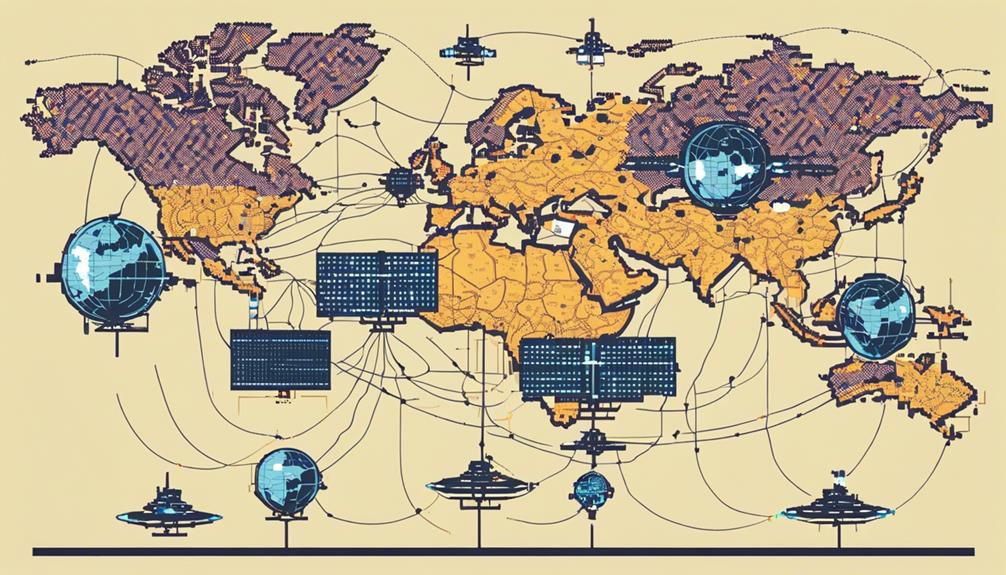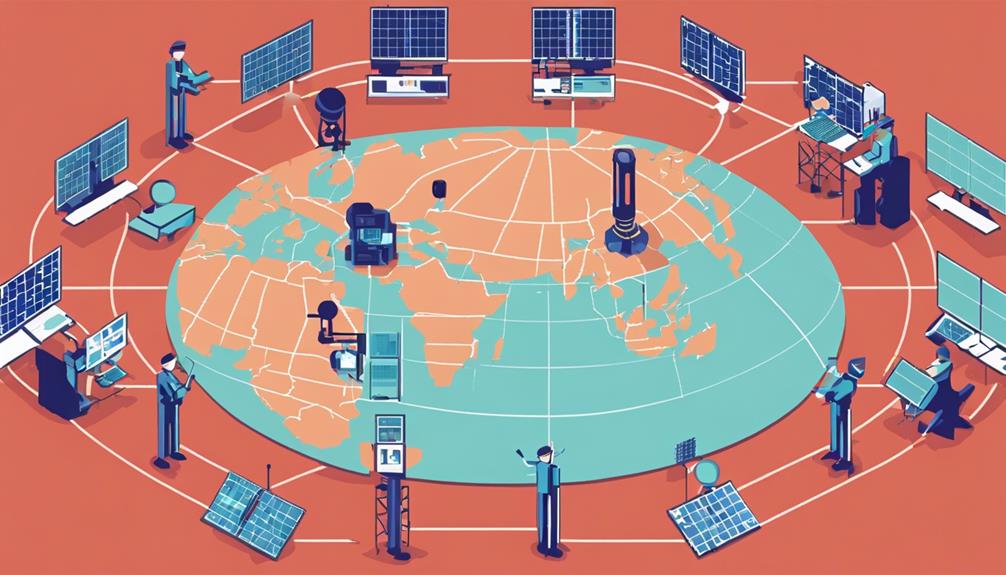The intricate web of satellite ground stations forms a critical backbone in the realm of satellite communications, serving as the linchpin for global connectivity and data exchange. This network, meticulously designed and strategically positioned, is a testament to human ingenuity and technological advancement. However, beneath the surface of seamless data transmission lies a tapestry of complexities and challenges that warrant closer examination. From signal interference to cybersecurity vulnerabilities, the landscape of satellite ground stations is rife with intricacies that demand meticulous attention and innovative solutions. As we peer into the complexities that underpin this global network, a deeper understanding emerges, shedding light on the fascinating interplay between technology, communication, and security in the realm of satellite operations.
Key Takeaways
- Satellite ground stations form a robust global network for efficient satellite communication.
- Strategic locations like Svalbard and Troll/Antarctica optimize coverage and connectivity.
- Network reliability and performance are ensured through advanced technology and meticulous maintenance.
- Future trends include security enhancements, AI integration, and technological advancements for seamless operations.
Significance of Satellite Ground Stations

The importance of Satellite Ground Stations lies in their indispensable role as the backbone of satellite communication systems, facilitating pivotal functions such as satellite tracking, data transmission, and global connectivity. Ground stations play a critical role in ensuring that satellites in various orbits can be tracked and communicated with effectively. They enable global coverage, allowing satellite operations to reach different parts of the world seamlessly.
In specialized cases, ground stations such as Svalbard and Troll/Antarctica are strategically located to provide unique access to polar orbits and regions, enhancing satellite communication capabilities in these areas. These stations offer specialized services tailored to meet the specific needs of satellite operators, ensuring smooth and reliable data transmission.
The design and integration of ground network solutions are essential for maximizing the performance, reliability, and efficiency of satellite operations. By establishing a robust network of ground stations, satellite operators can ensure that their systems operate at peak performance levels, maintaining constant connectivity and data transmission capabilities. Overall, the significance of Satellite Ground Stations cannot be overstated in the realm of satellite communication, playing a crucial role in supporting global connectivity and the smooth operation of satellite systems.
Global Distribution of Ground Stations
The global distribution of ground stations plays a crucial role in ensuring comprehensive coverage and seamless connectivity for satellite communication networks. Station locations worldwide strategically placed in key regions enable efficient data transmission and reception, enhancing network performance and reliability. As the demand for satellite services continues to grow, network expansion plans are essential to meet the evolving needs of the industry and maintain a robust infrastructure for global communication.
Station Locations Worldwide
With a global distribution spanning 26 locations, the network of ground stations for global satellite communications consists of 270 antennas. Key stations such as Svalbard, situated at 78° North, offer complete access to all orbits for sun-synchronous spacecraft. Another significant station is Troll in Antarctica, located at 72° South, which serves as the sole commercial ground station on the continent, providing connectivity to most orbits from the southern hemisphere. These stations play a crucial role in supporting polar orbiting satellites, enhancing global coverage and connectivity. The strategic placement of these ground stations ensures comprehensive access to satellite data and facilitates communication with satellites in various orbits, optimizing the network's functionality.
Connectivity and Coverage
Enhancing global satellite connectivity and coverage, the network of ground stations strategically located across 26 global sites plays a vital role in optimizing communication with satellites in various orbits. This network includes specialized stations such as Svalbard and Troll/Antarctica, offering tailored solutions for specific needs. Svalbard, situated at 78 degrees North, provides complete access to all orbits, especially beneficial for sun-synchronous spacecraft. On the other hand, Troll/Antarctica, located at 72 degrees South, is the sole commercial station in Antarctica, enabling connectivity to almost all orbits from the southern hemisphere. The combined coverage from these stations allows for twice-per-orbit connectivity for most Polar Orbiting satellites, demonstrating the network's commitment to performance and reliability.
Network Expansion Plans
An integral component of the strategic network development involves the global distribution of 270 antennas across 26 locations worldwide.
- The specialized ground stations, such as the Svalbard Ground Station, provide comprehensive access to all orbits for spacecraft in sun-synchronous orbits.
- The Troll/Antarctica Ground Station, positioned at 72 degrees South, is the sole commercial ground station in Antarctica, offering connectivity to nearly all orbits from the southern hemisphere.
- The combined coverage of the Troll/Antarctica and Svalbard stations enables connectivity twice per orbit for most Polar Orbiting satellites.
- Ground network solutions are customized to specific requirements, emphasizing optimal performance, reliability, and global reach for satellites in diverse orbits and locations.
Role in Satellite Operations
Ground stations serve as critical components in the intricate web of satellite operations, providing essential support for monitoring and communication with a vast array of satellites in orbit. The global network of satellite ground stations plays a pivotal role in satellite operations by enabling the reception and transmission of satellite data, facilitating collaborative tracking, and monitoring of satellites worldwide. With over 300 operational ground stations, this network has been instrumental in enhancing satellite communication technology and understanding satellite behavior.
This network of ground stations has monitored over 380 satellites equipped with 810 transmitters, conducting more than 12,000,000 observations and processing data frames exceeding 51,000,000. Such extensive monitoring and data processing capabilities are crucial for ensuring the smooth functioning of satellite operations. Moreover, the collaborative tracking and monitoring enabled by ground stations promote global cooperation in space exploration, allowing different countries and organizations to work together towards common goals.
Notably, the European Space Agency has leveraged ground stations for OPS-SAT CubeSat observations post-launch, underscoring the importance of these facilities in supporting satellite operations. Overall, the global network of satellite ground stations plays a vital role in the seamless operation, monitoring, and communication with satellites orbiting the Earth, contributing significantly to advancements in space technology and exploration.
Connectivity and Communication Networks

In the realm of satellite ground stations, the focus lies on data transmission processes, signal strength optimization, and network reliability factors. These critical aspects ensure seamless communication between ground stations and satellites, guaranteeing efficient data reception and transmission worldwide. By prioritizing these points, satellite operators can enhance their connectivity and communication networks, ultimately bolstering the performance and reliability of their satellite operations.
Data Transmission Processes
The optimization of connectivity and communication networks plays a crucial role in ensuring efficient data transmission processes within the global satellite ground station network. To achieve seamless data transmission, several key strategies are implemented:
- Utilization of advanced technology such as software-defined networking (SDN) and network function virtualization (NFV).
- Expansion of ground stations and investment in high-speed networks to enhance data transmission capabilities.
- Establishment of specialized ground stations in unique locations like Svalbard and Antarctica for optimal connectivity with satellites in various orbits.
- Integration of global coverage strategies to ensure continuous and reliable data transmission for satellite communication and observation purposes.
Signal Strength Optimization
Optimizing signal strength is paramount in ensuring the efficiency and reliability of connectivity and communication networks within global satellite ground stations. Ground stations worldwide prioritize maximizing signal strength to maintain seamless communication with satellites in various orbits. This optimization involves strategic antenna positioning, advanced signal processing techniques, and meticulous network design to enhance data transmission and reception capabilities. Continuous monitoring and adjustments are essential to uphold optimal signal strength levels, ensuring effective and uninterrupted communication between ground stations and satellites. By focusing on signal strength optimization, ground stations can guarantee reliable connectivity, enabling the smooth exchange of data and fostering seamless communication across the global network of satellite ground stations.
Network Reliability Factors
Enhancing network reliability factors in global satellite ground stations necessitates a comprehensive approach to optimizing connectivity and communication networks.
- Implement redundant communication links to ensure uninterrupted connectivity for satellite operators.
- Regularly maintain and upgrade antennas to enhance communication capabilities and minimize downtime.
- Utilize specialized ground stations strategically located to provide optimal coverage for satellites in different orbits.
- Offer high-value services tailored to the specific needs of satellite operators, maximizing network performance and reliability.
Operational Challenges and Solutions

Consistently managing a network of over 300 ground stations worldwide presents complex operational challenges that require meticulous coordination and strategic solutions. To address these challenges, the network has implemented various solutions, including the utilization of a web app to schedule observations and coordinate monitoring activities efficiently. This approach has enabled the network to conduct over 12,000,000 observations to date, demonstrating its operational capacity.
Given the task of monitoring 380+ satellites with 810+ transmitters, the network faces the challenge of ensuring efficient data processing and coordination among the ground stations. This necessitates the implementation of streamlined processes and protocols to handle the vast amounts of data generated by the observations effectively.
The success of the network heavily relies on the Network Operations Center (NOC) in London. The NOC plays a pivotal role in overseeing all network activities, ensuring the online status of ground stations, and coordinating communication between the various stations. Through the NOC's centralized monitoring and control, the network can address operational challenges promptly and maintain the seamless functioning of the ground stations worldwide.
Security Measures and Protocols
The implementation of robust security measures and protocols is paramount in safeguarding the integrity and confidentiality of data transmission within the global satellite ground station network. To ensure a secure environment, the following measures are in place:
- Encrypted Communication: Security protocols are established to enable encrypted communication channels, protecting data transmission from unauthorized access or tampering.
- Access Controls and Authentication Mechanisms: Ground stations are equipped with stringent access controls and authentication mechanisms to verify and permit only authorized personnel to operate the stations, reducing the risk of unauthorized interference.
- Security Audits: Regular security audits and updates are conducted to proactively identify and address potential vulnerabilities and risks within the network, enhancing overall security posture.
- Physical Security Measures and Emergency Response Plans: Physical security measures, including restricted access to station locations, bolster the infrastructure's protection. Additionally, comprehensive emergency response plans and protocols are established to swiftly and effectively manage security incidents, ensuring minimal disruption to operations.
Future Trends in Ground Station Technology

Evolution in ground station technology is driving advancements towards supporting higher data rates, frequencies, and integration of artificial intelligence (AI) and machine learning. Future ground stations are anticipated to leverage AI and machine learning for automated scheduling, data analysis, and anomaly detection, enhancing operational efficiency. Antenna technology is also progressing, with phased array antennas enabling more precise tracking of satellites in diverse orbits. The adoption of software-defined radio (SDR) technology in ground stations is on the rise, offering increased flexibility and adaptability to evolving communication standards.
Moreover, a potential future trend in ground station technology involves collaboration with emerging technologies like blockchain. Blockchain integration can enhance data management and authentication processes in ground station operations, ensuring secure and reliable communication with satellites. By utilizing blockchain, ground stations can securely manage data transmission, access, and storage, thereby fortifying the overall integrity of satellite communication networks. As ground station technology continues to evolve, the incorporation of AI, machine learning, advanced antenna systems, SDR technology, and blockchain solutions will play pivotal roles in shaping the future landscape of satellite communication infrastructure.
Frequently Asked Questions
How Many Ground Stations Are There in the World?
Ground station coverage worldwide encompasses a vast network dedicated to satellite tracking. The technology at these ground stations enables data reception from numerous satellites, requiring advanced signal processing and antenna systems. These stations, located strategically across the globe, facilitate remote operations for seamless connectivity within the global network. The precise coordination of ground station locations ensures efficient data transmission and retrieval for satellite monitoring and communication purposes.
How Do Ground Stations Communicate With Satellites?
Ground stations communicate with satellites through signal reception, data transmission, and antenna positioning. Signals are transmitted and received between the ground station and satellite, with antennas pointed towards the satellite for communication. Ground stations track satellite orbits, coordinate frequencies, monitor weather conditions, conduct remote operations, process signals, and track satellites using ground equipment. This precise process enables seamless communication between ground stations and satellites.
What Is the Purpose of the Ground Station?
The ground station serves as a pivotal site for signal reception, data transmission, and remote tracking of satellites. Through precise antenna alignment and frequency coordination, it enables satellite tracking, orbital adjustments, and space debris monitoring. Additionally, ground stations facilitate weather monitoring to optimize operational efficiency. Network connectivity is established to ensure seamless communication with satellites, allowing for the exchange of vital data and commands.
What Are the Application of Ground Station Satellite?
Just as a conductor orchestrates a symphony, ground stations coordinate a myriad of tasks with satellites. They facilitate data transfer, enable remote sensing for weather forecasting and earth observation, support telecommunications and navigation systems, aid in disaster management, conduct scientific research, assist in military surveillance, and propel space exploration. Ground stations are the silent heroes behind a multitude of applications that rely on the seamless interaction between satellites and Earth-based operations.

